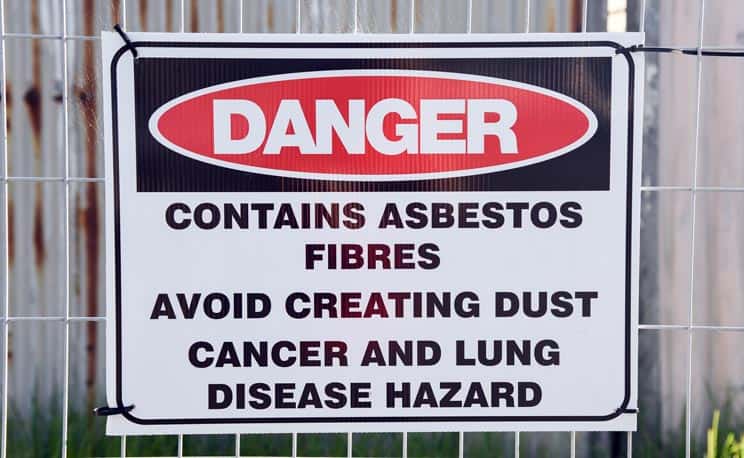Asbestos is a toxic substance that can have devastating effects on those who are exposed to it. Asbestos -related conditions are caused by the inhalation or ingestion of the microscopic asbestos fibers, which accumulate in the body and over time can seriously damage the lungs and other organs and systems. Treatment of asbestos exposure injuries are not only physically and emotionally taxing, but can also be an extraordinary financial burden on patients and their families. Because these injuries are most often due to the negligence of asbestos manufacturers and companies who allowed their employees to work with the toxic material (despite knowing the severe danger of doing so), there are legal protections and financial benefits for those who were unknowingly and unfairly exposed to asbestos and are diagnosed with an asbestos-related injury.
When considering filing a claim or pursuing litigation for an asbestos lawsuit, an important factor of the case is the statute of limitations. As stipulations for these limitations vary across types of cases and by state, understanding the elements of the statute of limitations is fundamental to filing an asbestos lawsuit and ensuring a proper settlement.
What Are Statutes of Limitations?
A statute of limitations is a law that defines the window of opportunity for a plaintiff to initiate legal proceedings in criminal or civil court. Generally, a statute of limitations begins on the date that an alleged offense takes place and extends through a specified period of time. Parties looking to seek justice through the pursuance of a claim or by bringing up allegations must do so during that allotted time.
Statutes of limitations are determined by state law and depending on the type and nature of a claim, the statute of limitations can vary significantly from one state to the next. Statutes of limitations are generally related to the severity of the violation. Serious offenses, like murder, are subject to a longer statute of limitations than lesser crimes, like petty theft.
These limitations promote timely proceedings and are implemented for practical reasons – to preserve important evidence pertaining to the case, for increased ability for witnesses to recall certain events and to ensure that justice is served within a considerable interval of time.

What Is the Statute of Limitations for Asbestos Claims?
Like all other legal sectors, asbestos-related lawsuits are bound by statutes of limitations which vary by state. Statutes of limitations for asbestos claims range from one to six years. Some states have an altogether different statute of limitations for wrongful death claims, where a victim succumbs to their asbestos-related disease, which ranges from one to three years. To find out the statute of limitations in each state for each of these claims, see the chart below.
Because the “start date” of most statute of limitations begins the date the injury is initiated, one might think the “clock” for asbestos claims begin from the time of asbestos exposure. However, in the United States the law views asbestos-related cases somewhat differently than other claims due to the extended time between the dates of asbestos exposure and detecting symptoms and diagnosing asbestos-related injuries. This extended timeline is the basis of the application of the discovery rule to asbestos lawsuits.
Discovery Rule for Asbestos Claims
Time is the number one factor for asbestos-related injuries. It can take anywhere from ten years to five decades for asbestos to cause damage which results in injury or disease. This has resulted in the law providing specific, additional guidelines to the statute of limitations of asbestos cases.
The discovery rule was implemented after a noteworthy ruling in the Eastern Texas District Court in 1973 (Borel v. Fibreboard Paper Products Corporation) contended that the statute of limitations begins at the time of diagnosis for personal injury claims and at the time of death for wrongful death lawsuits. This set the current standard protocol regarding the statute of limitations in asbestos cases, where the “clock” begins from the date of the asbestos-related injury diagnosis or the date the injured passed away from their asbestos-related disease.
Asbestos Statute of Limitations Vary by Types of Asbestos Claims:
The three areas of asbestos-related claims are divided among the following:
Asbestos Personal Injury Lawsuits
Personal injury lawsuits constitute the majority of mesothelioma and other asbestos-related injury cases and have helped thousands of people gain compensation from negligent companies who produced or caused their employees to work with asbestos-containing products. When someone is diagnosed with an asbestos-related disease, they are able to file claims and pursue litigation against asbestos manufacturers or contract employers for exposing them to the toxic substance. Damages and settlements awarded are most commonly applied to mitigate expensive medical treatments and loss of wages. The statutes of limitations for asbestos injury claims vary by state, detailed in the chart below.
Asbestos Wrongful Death Lawsuits
Wrongful death lawsuits are filed by next-of-kin or estate representatives (also known as an “executor”) on behalf of someone who died from an asbestos-related disease or cancer. In addition to covering treatment and lost wages, damages from wrongful death cases enable families to recover funeral or burial expenses or compensation for pain and suffering. The statutes of limitations for wrongful death claims vary by state, detailed in the chart below.
Asbestos Trust Fund Claims
Asbestos trust funds represent financial resources allocated to future asbestos injury patients by negligent companies that were implicated in exposing consumers to asbestos through their working environments or manufacturing processes. These funds ensure that victims have access to financial resources when they are diagnosed with an asbestos-related injury, even if the company has since gone bankrupt or ceased its operations. These types of funds allow the injured parties to file a claim with the trust itself, without needing to pursue litigation through the courts. The statutes of limitations for asbestos trust fund claims are not dependent on state law, rather each trust sets their own statute of limitations for filing a claim, which is generally 3 years.
Common Asbestos Exposure Diseases
If asbestos fibers are inhaled or swallowed and accumulate in the body, they can severely damage many organs and systems, causing serious diseases and cancers. Some of the most common asbestos exposure diseases include:
- Mesothelioma
- Lung cancer
- Laryngeal cancer
- Pharyngeal cancer
- Oropharyngeal cancer
- Asbestosis
- Pleural plaques
- Pleural thickening
- Stomach cancer
- Colorectal cancer
- Colon cancer
- Rectal cancer
- Ovarian cancer

Exceptions to Asbestos Statute of Limitations
If you or a loved one are interested in filing an asbestos lawsuit but believe your case no longer falls within the statute of limitations, know that there are some exceptions, exemptions and unique case circumstances that could render your case still valid, despite the expiration of the statute of limitations. Due to the intricate and complex nature of these types of cases, it is important to consult with an attorney who can help you understand if you can take advantage of an exception, or if your case is still viable. Contact The Law Center to be connected with a specialized asbestos attorney who can determine if your asbestos claim can still be filed. Call 833-716-0087 or fill out the form below to speak with an asbestos attorney today.
What State Should an Asbestos Claim Be Filed In?
Filing claims against former manufacturers or contract employers responsible for asbestos exposure is somewhat complicated due to possible numerous residences of the asbestos victim, interstate commercial activity and business registrations in multiple states. Due to these multiple options, it is best to consult an attorney or specialized law firm that can better answer questions related to jurisdiction and provide advice on a case-by-case basis. Determining the best state to file an asbestos-related claim depend on various factors including:
States Injured Has Lived
The state(s) where the victim is a current resident or any other states where they were primary residents.
States of Job Site of Asbestos Exposure
The state(s) where employment contracts were executed or states in which the victim was legally employed.
States of Asbestos Companies
The state(s) where companies that were responsible for the asbestos exposure were/are legally registered and where they had/have operational facilities.
Asbestos Statute of Limitations by State
The following chart gives an overview of the statutes of limitations for asbestos exposure cases by state and by type of claim.
| State | Personal Injury Statute | Wrongful Death Statute |
| Alabama | 2 years | 2 years |
| Alaska | 2 years | 2 years |
| Arizona | 2 years | 2 years |
| Arkansas | 3 years | 3 years |
| California | 1 year | 1 year |
| Colorado | 2 years | 2 years |
| Connecticut | 3 years | 3 years |
| Delaware | 2 years | 2 years |
| Florida | 4 years | 2 years |
| Georgia | 2 years | 2 years |
| Hawaii | 2 years | 2 years |
| Idaho | 2 years | 2 years |
| Illinois | 2 years | 2 years |
| Indiana | 2 years | 2 years |
| Iowa | 2 years | 2 years |
| Kansas | 2 years | 2 years |
| Kentucky | 1 year | 1 year |
| Louisiana | 1 year | 1 year |
| Maine | 6 years | 2 years |
| Maryland | 3 years | 3 years |
| Massachusetts | 3 years | 3 years |
| Michigan | 3 years | 3 years |
| Minnesota | 4 years | 3 years |
| Mississippi | 3 years | 3 years |
| Missouri | 5 years | 3 years |
| Montana | 3 years | 3 years |
| Nebraska | 4 years | 2 years |
| Nevada | 2 years | 2 years |
| New Hampshire | 3 years | 3 years |
| New Jersey | 2 years | 2 years |
| New Mexico | 3 years | 3 years |
| New York | 3 years | 2 years |
| North Carolina | 3 years | 2 years |
| North Dakota | 6 years | 2 years |
| Ohio | 2 years | 2 years |
| Oklahoma | 2 years | 2 years |
| Oregon | 3 years | 3 years |
| Pennsylvania | 2 years | 2 years |
| Rhode Island | 3 years | 3 years |
| South Carolina | 3 years | 3 years |
| South Dakota | 3 years | 3 years |
| Tennessee | 1 year | 1 year |
| Texas | 2 years | 2 years |
| Utah | 3 years | 2 years |
| Vermont | 3 years | 2 years |
| Virginia | 2 years | 2 years |
| Washington | 3 years | 3 years |
| Washington D.C. | 3 years | 2 years |
| West Virginia | 2 years | 2 years |
| Wisconsin | 3 years | 3 years |
| Wyoming | 4 years | 2 years |
The following chart gives an overview of the statutes of limitations for asbestos exposure cases by statute of limitations and by type of claim:
| Statute of Limitations | Personal Injury | Wrongful Death | ||
| 1 year | California, Kentucky, Louisiana, Tennessee | California, Kentucky, Louisiana, Tennessee | ||
| 2 years | Alabama, Alaska, Arizona, Colorado, Delaware, Georgia, Hawaii, Idaho, Illinois, Indiana, Iowa, Kansas, Nevada, New Jersey, Ohio, Oklahoma, Pennsylvania, Texas, Virginia, West Virginia | Alabama, Alaska, Arizona, Colorado, Delaware, Florida, Georgia, Hawaii, Idaho, Illinois, Indiana, Iowa Kansas, Maine, Nebraska, Nevada, New Jersey, New York, North Carolina, North Dakota, Ohio, Oklahoma, Pennsylvania, Texas, Utah, Vermont, Virginia, West Virginia, Washington D.C., Wyoming | ||
| 3 years | Arkansas, Connecticut, Maryland, Massachusetts, Michigan, Mississippi, Montana, New Hampshire, New Mexico, New York, North Carolina, Oregon, Rhode Island, South Carolina, South Dakota, Utah, Vermont, Washington, Washington D.C., Wisconsin | Arkansas, Connecticut, Maryland, Massachusetts, Michigan, Minnesota, Mississippi, Missouri, Montana, New Hampshire, New Mexico, Oregon, Rhode Island, South Carolina, South Dakota, Washington, Wisconsin | ||
| 4 years | Florida, Minnesota, Nebraska, Wyoming | |||
| 5 years | Missouri | |||
| 6 years | Maine, North Dakota |
Is My Asbestos Exposure Claim Within the Statute of Limitations?
The table above lists the statutes of limitations pertaining to personal injury and wrongful death lawsuits according to each state. If a claim remains within the corresponding state statute, it is important to gather all related information to better inform your claim or provide it to legal counsel to best prepare your case. Important disclosures include the following:
Type of Asbestos Claim
The first step in an asbestos claim is to discuss and evaluate which type of claim you are seeking to pursue. This can either be personal injury, triggered by an asbestos-related diagnosis or wrongful death which occurs after the passing of a loved one due to health complications from asbestos exposure. In many cases, there are applicable trust funds reserved for victims. This will help you and any corresponding legal counsel determine the best strategy for moving the claim towards receiving compensation for injury or loss.

State Where Injured Lives
If the home state of the injured has a longer statute of limitations for asbestos cases, it might make the most sense to file in that state. Important documentation such as personal identification, housing deeds and utility bills that prove the state of residence of the injured or the deceased will be important for filing a claim in that state.
When Injured Was Exposed to Asbestos
This information can come from a work contract or employment documentation stating the dates in which the victim was employed, registered to a particular job site or stationed in a certain workplace. This can also potentially be determined and better informed through medical pathology reports which often provide important information regarding the duration and time of asbestos exposure based on the progression of the asbestos disease or cancer.
State Where Injured Was Exposed to Asbestos
Similar to the duration in which the injured was exposed to asbestos, it is important to identify and provide specific information on the location where the asbestos exposure took place. This information can be available in personal or professional records, employment logs such as in contracts or in human resources databases. The authenticity and accuracy of this information has the potential to better determine some of the subjectivities of an asbestos-related case.
Asbestos injury claims can be complex and confusing to navigate on your own. Working with an experienced and skilled asbestos legal team is the best way to ensure you are eligible to receive the highest settlement possible for your case. Contact us by calling 833-716-0087 or filling out the form below to discuss your case with an asbestos attorney today.
State Where Company Responsible for Asbestos Exposure Is Located
After deciding to pursue an asbestos-related claim against a manufacturer or contract employer, it is important to provide sufficient jobsite and employer information on the entity responsible for exposure – their business name, facilities, and production locations where you may have worked. If the manufacturer or contract employer has been previously involved in a similar claim or lawsuit, this information could be available through public records or archived in a legal registry.
Date of Asbestos Exposure Injury Diagnosis
The day in which a victim received a diagnosis of an asbestos-related disease is a determining factor in filing a claim or pursuing a lawsuit. Medical documentation and reports corresponding to the identification of an asbestos-related disease or cancer is integral for defining the commencement of the statute of limitations for their asbestos claim.
Severity of Diagnosis and Progression of Asbestos Disease
In addition to the diagnostic reports, it is essential to document the progression of the asbestos injury throughout the different medical treatments or procedures used to manage the asbestos disease or cancer. This includes the list of medications and all treatments prescribed and recommended by a doctor as a result of the asbestos-related injury.
The ability to provide this information is vital to filing a successful asbestos claim or litigation. Due to the extensive civil procedures in evaluating and settling a claim or lawsuit, the decision to file a claim or pursue litigation is best done with the help of a legal expert or a specialized firm. Hiring legal counsel enables accurate and timely filings while simultaneously increasing the likelihood of success in reaching a high settlement. To be connected with a top asbestos legal team today, contact us by calling 833-716-0087 or filling out the form below.
Are You Looking to File an Asbestos Exposure Injury Claim?
The Law Center is here to place you in the best possible legal hands by pairing you with a leading asbestos legal team. That’s why we’ve partnered with the attorneys at the Environmental Litigation Group, P.C., a highly specialized firm who have helped over 15,000 clients get compensation from their asbestos exposure injuries over the last 30+ years. Their team of top-tiered asbestos attorneys have recovered over 1.4 billion in damages for their clients, and they are ready to diligently work for you to achieve the best financial compensation available for your asbestos injury case. Contact The Law Center by filling out the form below or by calling 833-716-0087 for a free consultation, and to find out what the team of experienced attorneys can do for you.
Sources
- https://www.cancer.gov/about-cancer/causes-prevention/risk/substances/asbestos/asbestos-fact-sheet
- https://www.mesotheliomadiagnosis.com/legal/mesothelioma-statute-of-limitations
- https://www.elglaw.com/about
- https://www.hhs.gov
- https://www.epa.gov/asbestos
- https://www.unenvironment.org/news-and-stories/story/asbestos-natural-environment-how-safe-are-we
- https://www.justice.gov
- https://www.osha.gov/SLTC/asbestos